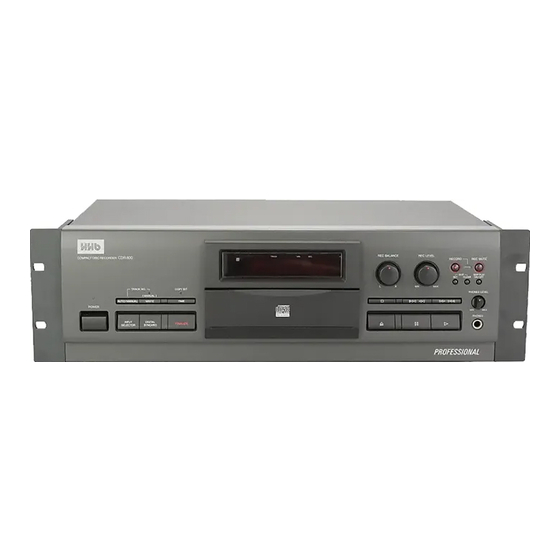
HHB CDR800 Product Review
Hhb compact disc recorder
Hide thumbs
Also See for CDR800:
- Quick reference manual (2 pages) ,
- Operating instructions manual (45 pages)
Advertisement
Quick Links
Download this manual
See also:
Quick Reference Manual
P
RODUCT
HHB Compact Disc Recorder
Reviewed by Gary Galo
HHB CDR-800 Professional Compact
Disc Recorder. HHB Communications
USA, LLC, 1410 Centinela Ave., Los An-
geles, CA 90025, (310) 319-1111, FAX
(310) 319-1311, E-Mail sales@hhbusa.
com; Website www.hhbusa.com.
HHB Communications is a British-based
firm specializing in digital audio record-
ing equipment and media for the profes-
sional audio industry. In addition to CD
recorders, HHB manufactures portable
DAT recorders, a line of vacuum-tube
processors (including mike preamps,
compressors, and parametric equalizers),
and studio monitor loudspeakers (includ-
ing nearfield monitors and powered sub-
woofers). HHB also distributes the Genex
line of high bit rate, high sampling rate
magneto-optical digital recorders. Their
complete line of digital media includes
professional-quality recordable compact
discs (CD–R), A DAT tapes, MiniDiscs
(MD), and rewriteable magneto-optical
(MO) discs.
The
CDR–800
Compac t
recorder (Photo 1) has been on the
market for over two years. At the time it
was introduced, the CDR–800 repre-
sented a price breakthrough in profes-
sional CD recorders. The list price of
$2200 has become irrelevant, since the
unit now sells for around $1200 at most
pro audio dealers.
32
Audio Electronics 2/00
R
EVIEW
The CDR–800 looks suspiciously like
the Pioneer PDR–05 and PDR–99 con-
sumer CD recorders, which are essential-
ly identical—the PDR–99 is marketed as
part of Pioneer's Elite line, and features
their glossy Urushi front panel and Rose-
wood side panels. While based on the
consumer models, the CDR–800 is actu-
ally manufactured by Pioneer for the pro-
audio user, and incorporates a number of
features not found on the consumer
units. The Pioneer consumer players
have only unbalanced (RCA) analog in-
puts and outputs, along with S/PDIF and
Toslink digital inputs and outputs. To
Disc
these interfaces, the CDR–800 adds bal-
anced XLR analog inputs, along with a
balanced XLR A ES/EBU digital input
(Photo 2).
All analog and digital outputs on the
CDR–800 remain unbalanced. This may
appear odd at first, but most pro audio
users are likely to use the CDR–800 with
an external digital processor for play-
PHOTO 2: Rear panel of the CDR–800.
In addition to the RCA-type analog and
digital inputs, balanced XLR analog in-
puts and an AES/EBU balanced digital
input are also provided.
back, making balanced analog outputs
unnecessary. One other important differ-
ence between the CDR–800 and its Pio-
neer counterparts concerns the types of
recordable CDs you can use. The Pioneer
consumer machines will only recognize
consumer-type CD–R blanks. The
CDR–800 will also work with computer-
type CD blanks. The CDR–800 is also
equipped with standard 19-inch rack
mounts.
One impor tant feature of the
CDR–800 is Pioneer's Stable-Platter
mechanism (Photo 3), which includes a
full-size platter upon which the CD is
placed upside down. There are a couple
of advantages to this system. First, the
disc is supported over its entire surface,
minimizing vibration, which, in turn,
should reduce clock jitter. This serves
the same purpose as the disc dampers
many of us have used, but Pioneer's solu-
tion is far more effective. Second, the
laser now faces down, so it is far less like-
ly to accumulate dust.
Operation
Operationally, the HHB CDR–800 is ex-
tremely well thought out, and is really
not much more difficult to operate than
an analog cassette deck. For the most
PHOTO 1: Front view of the HHB CDR–800 Profes-
sional Compact Disc Recorder and its remote control.
Advertisement

Summary of Contents for HHB CDR800
- Page 1 For the most PHOTO 1: Front view of the HHB CDR–800 Profes- sional Compact Disc Recorder and its remote control. Audio Electronics 2/00...
- Page 2 PHOTO 3: A close-up view of the Pioneer Stable-Platter mechanism used in the part, the manual is clearly written, and CDR–800. The CD must be inserted up- includes numerous illustrations. Input side down, but this mechanism greatly and output connections are straightfor- reduces disc vibration and dust accumu- ward, but the rear panel also contains a lation on the laser pickup.
- Page 3 tomatically generates a track number on “finalization,” which allows the CD–R to for track selection are not included on the CD. It makes sense to prepare a DAT be played on any conventional CD play- the main chassis of the CDR–800. Re- master, including all of the index points er.
- Page 4 Most of these allow you to print or write ing HHB, and they have licensed the tech- on a circular label with adhesive backing. nology to other manufacturers as well.
- Page 5 I’m not familiar with the analog-to-dig- ital converter chip—it bears the part number AK5340–VS. HHB claims it uses the latest 1-bit conversion system, which is completely free of zero-crossing distor- tion. The A/D chip design also elimi-...
- Page 6 PD2028B Pulsef low D/A conver ter nect between your source and the HHB chips, which are actually stereo devices, recorder. with left and right audio outputs. To im- The dated op amps mentioned previ- prove low-level linearity, an entire chip is...
















Need help?
Do you have a question about the CDR800 and is the answer not in the manual?
Questions and answers